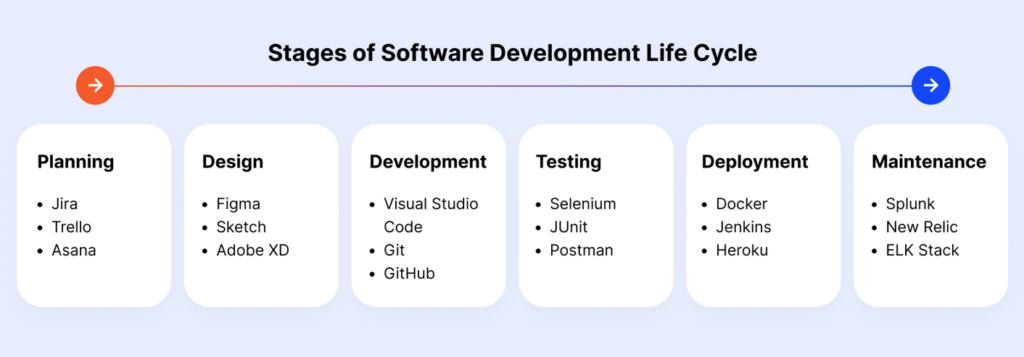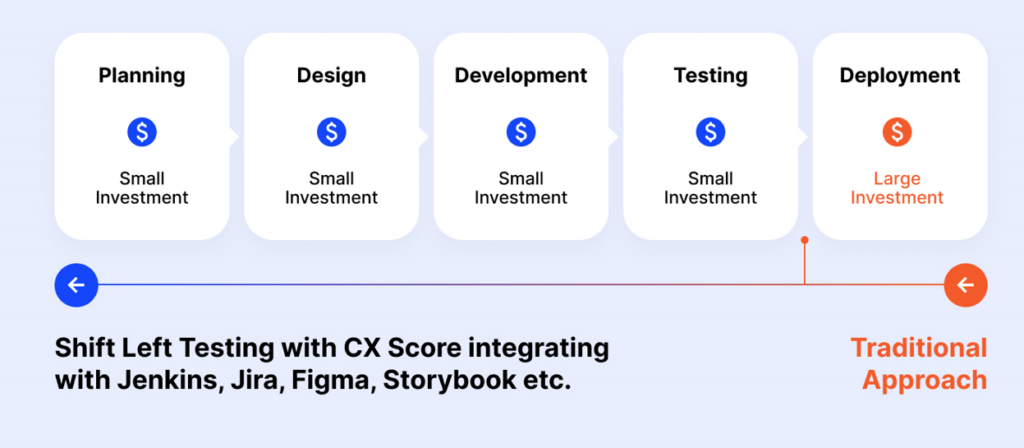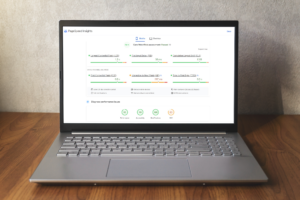Software accessibility is the process of designing and building software that can be easily used by all individuals, including those with visual, auditory, cognitive, or movement disabilities. Unfortunately, accessibility is often overlooked in the software development process leading to issues such as inadequate user experiences, expensive and time-consuming modifications, regulatory compliance violations, and even potential lawsuits.
To avoid these issues and consistently deliver accessible digital experiences, it’s crucial for software teams to adopt a proactive approach towards accessibility – testing from the very beginning of the development process. This approach is known as “shift-left,” which involves addressing accessibility concerns at every stage of development, and as early as the design stage, rather than waiting until the end.
At CX Score, we are ardent advocates of the “Shift-Left” philosophy, a deeply ingrained commitment within our organization, championed by our Founders, CEO Anjan Venkatramani and CTO Ashwin Rao. In this post, we will look at how a Shift-Left approach to accessibility benefits organizations and how CX Score is helping shift accessibility even further to the left into the design stage.
What is Shift-Left Testing for Accessibility?
Shift-left testing with accessibility refers to incorporating accessibility testing practices early in the software development lifecycle, aligning with the shift-left testing approach. Specifically, it emphasizes integrating accessibility considerations from the initial stages of design and development, rather than addressing them later in the cycle or after the product release.
The significance of implementing this approach right from the design and development phase was eloquently articulated by Rakesh Paladugula, a leader in the digital accessibility space, who underscored the importance of considering accessibility aspects even in tools like Figma and Storybook.
Shift-Left Testing with Accessibility in different stages of SDLC
Integrating accessibility into shifting-left methodology entails the utilization of accessibility principles, standards, and best practices throughout each phase of the Software Development Life Cycle (SDLC), ranging from initial planning and design to final development and deployment.

- Planning: Define the software product’s accessibility goals, scope, needs, and success criteria. Determine the user personas, scenarios, and assistive technologies that will be used. Conduct research and analysis on accessibility to better understand user needs and expectations. Create project accessibility guidelines and checklists.
- Design: Create accessible user interfaces and interactions by applying accessibility principles and standards such as WCAG 2.1 or 2.2. To ensure readability and usability, use color contrast tools, font size calculators, and other design tools. Conduct accessibility audits and evaluations to ensure that the design meets the accessibility standards. Incorporate feedback from disabled users into design revisions. This approach also involves the active engagement of all stakeholders, including product owners, developers, testers, designers, and end users, in the accessibility process.
- Development: To put the design into action, use accessible coding approaches and frameworks. To find and fix accessibility issues in code, utilize code analysis tools. As part of the continuous integration and delivery pipeline, use automated testing tools to execute accessibility tests. To validate the functioning and behavior of the product, use manual testing techniques such as screen readers or keyboard navigation.
- Deployment: Transfer the software to a staging or production environment. Use a combination of automatic and manual tools to do end-to-end accessibility testing. To do usability and user acceptance testing, use genuine users with disabilities or specialists. Monitor and evaluate the software product’s accessibility performance and user input.
Advantages of a Shift-Left Approach to Accessibility
Shifting left with accessibility in the software development life cycle (SDLC) offers several advantages:
- Early Issue Identification: By incorporating accessibility testing in the early phases of development, issues can be identified and addressed before they become more complex and costly to fix.
- Cost Savings: Resolving accessibility issues early in the SDLC is more cost-effective than addressing them later, preventing potential legal consequences, rework, and associated expenses.
- Time Efficiency: Early identification and resolution of accessibility issues save time that would otherwise be spent on extensive testing and rework in later stages.
- Enhanced Collaboration: Including accessibility considerations from the beginning encourages communication between designers, developers, and testers, fostering a collaborative and inclusive development process.
- Risk Mitigation: Addressing accessibility concerns early helps in complying with regulations, reducing the risk of legal consequences, and maintaining a positive brand image.
- Better User Experience: Early accessibility testing ensures that the final product is more inclusive, providing a better experience for users of all abilities.
The CX Score Approach: Shift Left for Accessibility

At CX Score, our commitment to the “Shift-Left” philosophy goes beyond a mere concept; it’s a seamlessly integrated approach embedded in every facet of the Software Development Life Cycle (SDLC). We recognize that true inclusivity begins with the planning phase, where CX Score facilitates the definition of precise accessibility goals, scope, and success criteria. Our platform supports teams in identifying user personas, scenarios, and assistive technologies, backed by thorough research and analysis.
In the design phase, CX Score empowers the creation of accessible user experiences by applying rigorous standards like WCAG 2.1 or 2.2. Our platform integrates cutting-edge tools, including color contrast utilities, font size calculators, and other design aids, ensuring optimal readability and usability.
As development kicks in, CX Score champions accessible coding approaches and frameworks, ensuring that every line of code conforms seamlessly with accessibility standards. The CX Score platform leverages sophisticated code analysis tools to pinpoint and rectify potential accessibility issues. For continuous integration, automated testing tools like Axe-coreⓇ and Jest-AxeⓇ are seamlessly woven into the development pipeline, ensuring swift and efficient execution of accessibility tests.
As we move into the deployment phase, CX Score facilitates end-to-end accessibility testing in staging or production environments, employing a dynamic mix of automated and manual tools. User acceptance testing involves genuine users with disabilities or specialists, providing invaluable insights into the product’s usability. Our platform goes a step further by actively monitoring and evaluating the software product’s accessibility performance and user input.
Beyond the SDLC, CX Score integrates seamlessly with popular platforms like Jenkins, Jira, Figma, and Storybook, amplifying our commitment to accessible digital experiences. In particular, our integration with Figma ensures that design teams have real-time insights into accessibility considerations, streamlining the design-to-development transition. Storybook integration further enhances this process, validating accessibility at the UI component level, guaranteeing that accessibility is not just a compliance checkbox but a part of every user interaction.
This cohesive integration extends the impact of the “Shift-Left” philosophy, creating a digital world where accessibility is not just a consideration but a fundamental aspect of design and development, ensuring that no one is left behind.
As we embrace the future of digital inclusivity, CX Score’s dedication to the “Shift-Left” approach in accessibility is not just about meeting standards; it’s about reshaping the digital landscape to be inherently accessible, embedding accessibility deeply into every stage of the SDLC. This commitment ensures that every digital product is not only compliant but inherently designed with inclusivity at its core. By pioneering this approach, we are helping to create a digital world that truly caters to everyone, and reinforcing the belief that accessibility is not an afterthought, but a fundamental pillar of modern software development. Join us in this journey towards a more accessible and inclusive digital future.



